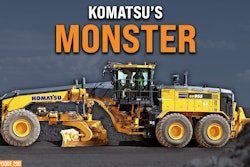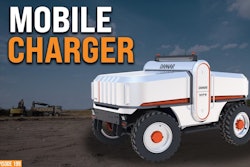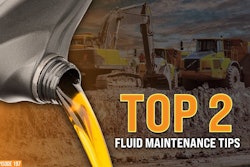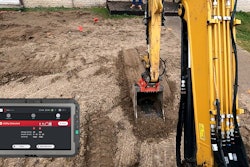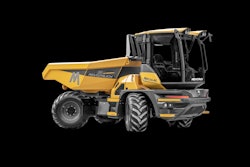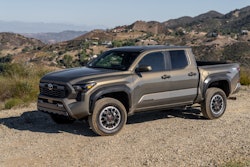Earlier this year Caterpillar unveiled its Next Generation compact track loaders and skid steers, marking the biggest updates to the models in over a decade.
Amid the rollout, the company revealed its largest-ever CTL, the 13,669-pound 285 XE.
“It’s a big, strong machine,” says our guest on The Dirt, Cat Senior Product Consultant Trevor Chase.
Not only is it big and strong, it is a complete redesign from previous generation Cat CTLs. It can handle high-flow attachments like mulchers and cold planers. It also gets heftier lift height and capacity, as well as increased breakout forces.
The cab gets big changes as well, with hints to the cockpit for a fighter pilot with its advanced joysticks that enable all functions at the operator’s fingers.
Cat fans and all those interested in compact track loaders will want to watch this latest episode of The Dirt to see the slew of features and capabilities packed into this compact yet hefty loader.
Equipment World serves up weekly videos on the latest in construction equipment, work trucks and pickup trucks – everything contractors need to get their work done. Subscribe and visit us at equipmentworld.com!
In This Episode:
- 00:00 – Cat’s Largest CTL: The 285 XE
- 00:24 – Cat 285 XE Overview
- 02:17 – The Evolution of CTLs
- 03:50 – New Equalizer Bar Undercarriage
- 06:08 – Rated Operating Capacity
- 09:49 – Cat Next Generation Improvements
- 13:58 – Pricing
- 15:06 – Final Thoughts
00:00:00:09 - 00:00:23:09
Bryan Furnace
Today we're here to talk about the humble skid steer. We're here to talk about Caterpillar's new 285 skid. And here to help us with information on that product is Trevor.
00:00:23:11 - 00:00:27:02
Bryan Furnace
Well, Trevor, thank you so much for taking time to be on the dirt today. I appreciate your time.
00:00:27:07 - 00:00:32:21
Trevor Chase
Thank you for having us on. This is a it's an exciting time and really appreciate the chance to talk with you.
00:00:33:00 - 00:00:46:14
Bryan Furnace
Yeah, absolutely. It is. Is it? It is an exciting time. We're getting into these bigger and bigger skid steers, and I'm eager to hear about some of the new stuff that's coming. So that being said, will you give us kind of an overview of the 285 and what it's bringing to the table?
00:00:46:17 - 00:01:10:15
Trevor Chase
Sure. So 285 XY this is a size class of machine that we've not had before. So this is an all-new platform for Cat. So this machine it's a big strong machine on the Z. You can get up to 134 horsepower. Wow. To be able to run, you know, hungry attachments. Right. Things like motors and coal planers, whatever it may be.
00:01:10:15 - 00:01:31:23
Trevor Chase
But that's just one aspect of it. So you get a lot of horsepower. You get a lot of hydraulic power, a lot of flow, a lot of pressure to be able to run those attachments. But also, we have things like 146in a B pin lift height. Wow. Really strong lift and tilt forces. So we've increased the breakout forces in those machines.
00:01:32:00 - 00:01:56:12
Trevor Chase
And we've also increased just overall capability. Our stability of the machine. And then of course all of the other neat things also inside the cab, you know, changing to that new next gen cab and making that common among all the next gen machines. So difference in undercarriage. Also, we made some changes and moved away from the torsion bar suspension that we've traditionally had in that 299 and in the 275 and the 285.
00:01:56:12 - 00:02:17:06
Trevor Chase
We now have an equalizer bar type of undercarriage that we can talk about here coming up. But this thing is a clean sheet of paper design. Yeah. All of the DNA that we have had and learned about in the last 25 years of making, skid steer loaders and track machines, it goes in there. It's pretty awesome.
00:02:17:08 - 00:02:36:01
Bryan Furnace
Yeah, that is it's it's so interesting to see how these machines have evolved. You know, it. Back in the day, it was it was exciting to have this little machine that was just really versatile. And it could do 360 spins and and you know, it was nice. And now we've moved into this space where a 130 horsepower out of one of these little units.
00:02:36:01 - 00:02:57:23
Bryan Furnace
I mean, they've gone from being a handy little tool to these are powerhouses on the job, and you're able to move unbelievable amounts of material. And we've used them in such a variety of applications. And now all of the sudden they're not just productive at moving dirt. These are becoming a main tool in land clearing operations, where that used to be reserved for dozers and excavators.
00:02:57:23 - 00:03:04:02
Bryan Furnace
And now these skid steer is really coming in and making an impact. So it's awesome to see what the industry has done with these machines.
00:03:04:04 - 00:03:25:23
Trevor Chase
Yeah, it you know, asset utilization comes in a lot now with these machines because of their capabilities. In all fairness, they're able to replace other machines. Now they may not you know the 285. We don't put it out. There's this is a replacement for a dozer right. Like this isn't replacing a D1 or D2 or D3 dozer, but can it go out there with a with a smart dozer blade and do some work?
00:03:26:00 - 00:03:43:23
Trevor Chase
Absolutely. Right. So asset utilization with these machines man it's really changed the game. Like like you said I mean they are they're becoming prevalent on on these job sites where it used to take a whole handful of machines. Now that's not necessarily the case.
00:03:44:01 - 00:03:59:02
Bryan Furnace
Yeah absolutely. It's it is like I said, it's just fascinating to see the evolution of these machines. So that being said, let's talk about more the equalizer bar and how that's different from the old-style torsion bar. What does that do for us. What are the advantages.
00:03:59:08 - 00:04:28:00
Trevor Chase
So the E bar undercarriage that stands for equalizer bar. That is a design that we've borrowed from our small track type tractor group. It's been in dozers for the longest time, and what you have is you have an E bar in the front of the machine, and it allows the machine or the the undercarriage itself, right, to go over uneven ground and still get that movement torsion bar before it used to be for independent torsion axles to up front to in the rear.
00:04:28:01 - 00:04:53:01
Trevor Chase
And it would allow the machine to be able to go over uneven ground and the undercarriage would move accordingly. When you get to those bigger machines that we're talking about now that the 275 and the 285, we heard a lot from voice a customer out there. And, operator, that stability was more important in these bigger machines, and they wanted to feel more stable because they want to lift heavy loads and lift them high.
00:04:53:03 - 00:05:15:15
Trevor Chase
So this E bar allows a whole lot more stability, but yet still giving you some of that flex and some of that ability to have better ride comfort, better material retention, better track life compared to as if it were just a fixed or welded solid undercarriage on there. So front front equalizer bar allows the tracks to to move like this.
00:05:15:20 - 00:05:32:04
Trevor Chase
There's a pivot shaft in the rear that allows them to move so that it it does that and really gives you like I said that a that ability to to have a little bit more comfort and a lot more stability. Especially with the fact that these things can lift so much weight and lift them so high now.
00:05:32:10 - 00:05:51:23
Bryan Furnace
Yeah. And that has always been a concern, I think, as an operator is when you really start getting into those heavy loads on uneven ground, especially with a track machine, you know, we're really the majority of the industry at this point. I think we can all openly discuss when we say skids here, we really mean to settle. That's that's what the majority of the industries use.
00:05:51:23 - 00:05:52:09
Trevor Chase
Absolutely.
00:05:52:15 - 00:06:19:08
Bryan Furnace
And when you get on that uneven ground, not having those tracks firmly planted, having that kind of teeter totter, the rocking effect going on, you know, that's a little unnerving when you get into those heavy loads. So I can see where that sort of stability would be a massive improvement. So let's kind of dive into now the difference between static stability versus dynamic stability and how that relates to rated operating capacity.
00:06:19:08 - 00:06:40:01
Bryan Furnace
And just for the audience's sake, rated operating capacity when you're just at any dealership is just this number, and it's this number that we all think we can take every machine and we can level it down to this, and that's going to put them all on an even playing field. But you're saying that's not necessarily the case. Can you explain the difference between the two and why rock can change as a result?
00:07:21:13 - 00:07:46:03
Trevor Chase
Absolutely. Love to. So you're absolutely right. Our rock is this number that the industry uses in order to just kind of classify machine sizes, and that rated operating capacity is a percentage of the tipping load. Tipping load is the amount of weight it takes when you pull down on a bucket. And it's for this point out to get, either the rear tire or the rear idler to come off the ground.
00:07:46:05 - 00:08:20:03
Trevor Chase
But that's on a flat piece of concrete, right? It's done. And, you know, machines are not running. They're sitting there static. They're not moving, they're not actually doing any work. So we all use that same test. And so therefore we compare that. But at the end of the day, when it means getting out there and doing the actual work, the rock kind of I mean, get you in the neighborhood of understanding where you know what machines can do, but it absolutely does not, you know, say for sure that this is what this machine can pick up or this is what you can go and do with the machine.
00:08:20:03 - 00:08:53:18
Trevor Chase
And we found that a lot with our testing, with our next gen machines because we went in wanting greater stability, especially because we're putting on bigger lift cylinders, bigger tilt cylinders, wanting to lift more weight. We're like, you know what? We've got to make the machine more stable. And so by doing these stability changes, this dynamic stability, which means what happens when you're running the machine and you've got, you know, 5,000-pound pallet or, you know, a blasting mat or whatever it may be and, and whatever load center that may be.
00:08:53:18 - 00:09:16:15
Trevor Chase
And as that changes, that actually changes how much a machine can actually lift and whether it's going to nose over, you know, when you start to go over uneven ground. And so we really focused on making sure, okay, yeah, let's have this good rating for spec, but let's make sure that when people are actually running the machines that they're like, wow, I thought for sure that I was going to go forward, and the machine couldn't handle that weight.
00:09:16:21 - 00:09:40:02
Trevor Chase
That's where that static stability versus dynamic stability comes in. Dynamic stability is where it's at. And we always discuss this with our dealers when they come in for training. There's nothing out there. There's no industry measurement for dynamic stability right. It's just not it's one of those things of a it's a seat of the pants feeling. And that's hey, I totally understand it.
00:09:40:04 - 00:09:46:21
Trevor Chase
But that's why we're you know, we tell people, you got to try these machines. You got to sit in them, you got to run it, and you got to feel the difference.
00:09:46:23 - 00:09:57:14
Bryan Furnace
Yeah, absolutely. So my final question for you is any other performance improvements or features available on the new machines versus the predecessors?
00:09:57:16 - 00:10:20:06
Trevor Chase
Yeah. So other than me taking the easy way out to say everything, there's some really exciting things in it. The cab itself, it's a much bigger cab, than we've ever had before. We've made a lot of improvements. We have heated and ventilated seats. We've changed where all of the buttons are. For any type of operator adjustment, you can get an optional eight-inch touchscreen monitor.
00:10:20:10 - 00:10:47:12
Trevor Chase
With the advanced joysticks, you don't have to take your hands off the joysticks ever to do anything in the monitor or anything with your work tools. It's all right there. We've also done some really cool things with the new 275 and 285 and offered rear auxiliary hydraulics. You can put things like a winch or a square or fire stabilizers and whatever might come down the road, things that you may want on the rear of the machine on its own dedicated circuit.
00:10:47:13 - 00:11:23:07
Trevor Chase
So it's not been tapped into the front auxiliary hydraulics. It would have its own dedicated circuit. And we're going to offer those attachments factory from caterpillar. So they're designed and built for it. So just so many things when when you talk about the performance itself, the power with the new Cat engine being that 3.6 turbo after cooled engine and getting that mass amount of horsepower and torque out of it back in the engine bay, where we've simplified serviceability even more, you get in the back of that machine and you can feel like you can crawl in it, yet at the same point, still have a machine where you have fantastic visibility when you're in
00:11:23:07 - 00:11:48:19
Trevor Chase
the operator seat. So lot of really cool things in there. Again, keep saying, just like when it comes to the stability aspect, people need to get in these things because it's been 11 or 12 years since we've had a new series machine. What you may have seen with caterpillar before or known previously, it's different. There's so many really great, great changes to these machines that you got to get in it, sit in it and try it.
00:11:48:21 - 00:12:10:02
Bryan Furnace
Yeah, it is interesting. Just all of the aspects you're talking about the the comfort of the cab. I mean, there's so many people in the industry that just get so caught up on, well, every year these kids years get more and more expensive. But the machines they're referencing back to are the machine that they had in 1985. That was a barebones machine with, you know, 40 horsepower, and it barely did what it needed to do.
00:12:10:02 - 00:12:33:00
Bryan Furnace
And and now we're, you know, as you're describing this, it occurs to me it's almost like you've you've combined a almost luxury vehicle, not quite, with a jet fighter. And in the sense of you talking about being able to go into your screen and do a lot of things without even taking your hands off the controls, it just occurred to me the modern day operator is getting closer and closer to a fighter pilot.
00:12:33:00 - 00:12:55:21
Bryan Furnace
In the standpoint of on the fly, we're able to go in and change settings and be more efficient without having to remove our hands off of the controls, and that means that we can go into these machines and move more, more efficiently, while still being comfortable over the duration of a very long day. And it's just it's so fascinating how far these machines have come in.
00:12:55:21 - 00:13:16:18
Trevor Chase
You're 100% right. And funny story, as we were developing, this machine, I called our joysticks at the time, the F-35 joysticks, because it was exactly that type of field that you were talking about. We were like, man, I feel like I'm a fighter pilot in this thing, right? Like I've got yeah, that is so crazy to be sitting in the seat and have complete control right here in my hands.
00:13:16:20 - 00:13:35:00
Trevor Chase
That's exactly why we've done that. You know, we want to be more productive. And and when it comes to skid steers, I mean, productivity has never you know, it's almost been a naughty word for so long when it comes to skid steers because, hey, nobody judges productivity with skid steers. Yeah. No one really judges it too hard. But you know, it.
00:13:35:01 - 00:13:54:16
Trevor Chase
You know when you're being more productive or less productive. Right. And so it matters. And it mattered for us to make sure that people who were getting out of other machines and into these machines, or whether this was their only machine, were as productive as they could be, because, yeah, machines are expensive. It doesn't matter what you get.
00:13:54:18 - 00:14:14:10
Trevor Chase
Yeah, some are more expensive than others, but they're expensive. And that was we also had some sensitivity to that brain as we develop these machines, because we do offer all these things. I'm here talking about how great; you know, the fighter pilot joysticks are with the advanced monitor and things of that nature. And people would be like, oh, that's Cat, you know, too expensive.
00:14:14:10 - 00:14:33:21
Trevor Chase
I don't I don't need that. Well, hey, we've got other configurations where you don't have to have all of that technology. If you don't want it. Right. We can you can still have all that same power that that machine has, and your dealer can, can get it to where you don't have to have you don't want ventilated seat.
00:14:33:22 - 00:14:59:18
Trevor Chase
You don't have to have ventilated seat. You want the standard monitor. That's still a really nice monitor. But you don't want the eight-inch touchscreen. We can configure it that way for you to. Right. And we can configure it with fully functional joysticks but not those advanced joysticks. You know, there's a whole bunch of ways to say, hey, we can give you all the benefits that a cat machine can give you, and you don't have to go and have the highest configuration if you want it.
00:14:59:20 - 00:15:06:02
Trevor Chase
That's great. If that's not for you, we've got other levels of configurations to fit all budgets and all styles of work.
00:15:06:06 - 00:15:11:17
Bryan Furnace
Absolutely. We'll. Trevor, thank you so much for all of the information. And this gets to your nerd out I appreciate it.
00:15:11:18 - 00:15:16:10
Trevor Chase
No my my pleasure love talking to you. It's been a great, great time.
00:15:16:12 - 00:19:37:21
Bryan Furnace
Well thank you again for Trevor and Caterpillar coming on the show to talk about the new 285 XY. As you can see, the humble skid steer is not so humble anymore. And it's bringing a lot of power to the table. So as always, I hope this information helps you and your business. We'll catch you on the next episode of The Dirt.
00:19:37:23 - 00:19:38:05
Trevor Chase
